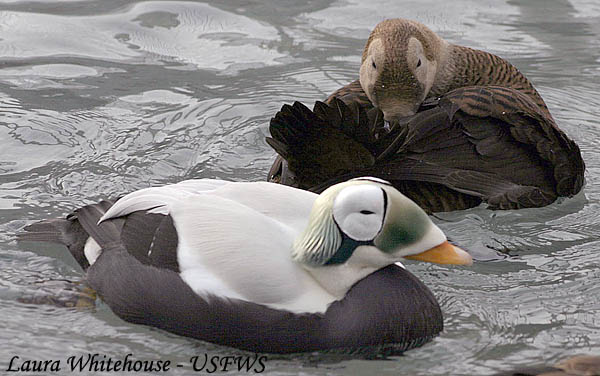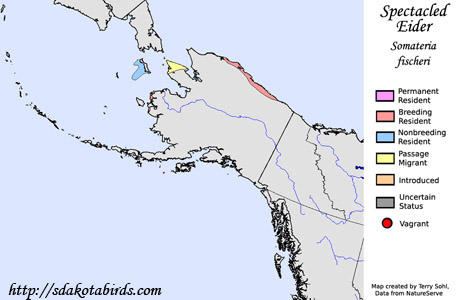| Length: 20 inches | Wingspan: 32 inches | Seasonality: Non-resident in South Dakota |
| ID Keys: Adult breeding males unmistakable. Nonbreeding males much plainer, but maintain unique head structure. Females brown with dark barring. "Goggles" present on all Spectacled Eiders in all seasons, as is the feathering on the bill that extends all the way down to the nostrils. | ||
 The
Spectacled Eider is a unique sea-duck that can be identified by the
"goggles" that are apparent on both sexes, and in all seasons. They
used to breed around most of the Alaskan coastline, but numbers there have
precipitously declined in recent decades. Much stronger populations
are found in Siberia, although there is also some evidence of a decline
there. The ingestion of lead shot or a chemical contaminant may be
primary contributors to the species' decline. Oil and gas drilling in their
primary habitat may also be hurting the species.
The
Spectacled Eider is a unique sea-duck that can be identified by the
"goggles" that are apparent on both sexes, and in all seasons. They
used to breed around most of the Alaskan coastline, but numbers there have
precipitously declined in recent decades. Much stronger populations
are found in Siberia, although there is also some evidence of a decline
there. The ingestion of lead shot or a chemical contaminant may be
primary contributors to the species' decline. Oil and gas drilling in their
primary habitat may also be hurting the species.
Habitat: Spectacled Eider are found on Alaskan tundra near the coastline in summer, although they can sometimes be found well inland. At other seasons they are typically found in the open ocean far offshore.
Diet: Mostly feeds on mollusks when available, but will also feed on aquatic (and rarely terrestrial) insects, crustaceans, and plant material.
Behavior: Strong divers, much of their food is obtained by diving and swimming underwater. During the summer breeding season, they will also behave like dabbling ducks in shallow freshwater ponds, and will also sometimes feed on land when foraging on plant material.
Nesting: The Spectacled Eider nests on Alaskan tundra, typically very near to the shoreline of a freshwater pond or lake. The nest is usually a small depression in a ridge or other small rise near the water, lined with down and vegetation. The female alone incubates the eggs. Upon hatching, the young leave the nest very soon and gather food themselves, although the female will protect them from predators.
Song: Generally a silent species, although the female will occasionally give some quiet clucking sounds.
Migration: Spectacled Eiders in the North American part of their range breed in multiple locations around the western and northern Alaskan coast. In winter, populations are typically found far out in the Bering Sea, far from shore.
Interactive eBird map: Click here to access an interactive eBird map of Spectacled Eider sightings
Similar Species: Males in breeding plumage are distinctive if seen well. General shape and structure of the species may lead to confusion with the Common Eider if not seen well.
Conservation Status: The IUCN currently lists the Spectacled Eider as a species of "Least Concern", largely due to the large range of the species. However, the U.S. Fish and Wildlife Service lists the species as "threatened throughout its range" in Alaska. Numbers have sharply declined in recent decades for reasons that aren't completely understood. Populations are evidently much stronger in other parts of its circumpolar range, such as populations in Russia.
Further Information: 1) Audubon.org - Spectacled Eider
2) Ducks Unlimited - Spectacled Eider
3) Alaska Department of Fish & Game - Spectacled Eider
Photo Information: February 23rd, 2006 - Alaska Sea Life Center in Seward, Alaska - Photo by Laura Whitehouse of the U.S. Fish and Wildlife Service - Photo licensed under Creative Commons Attribution 2.0 Generic license.
| Click below for a higher-resolution map |
 |
| South Dakota Status: Non-resident in South Dakota |
Additional Spectacled Eider Photos (Coming Soon!)
